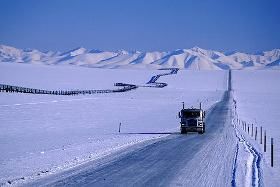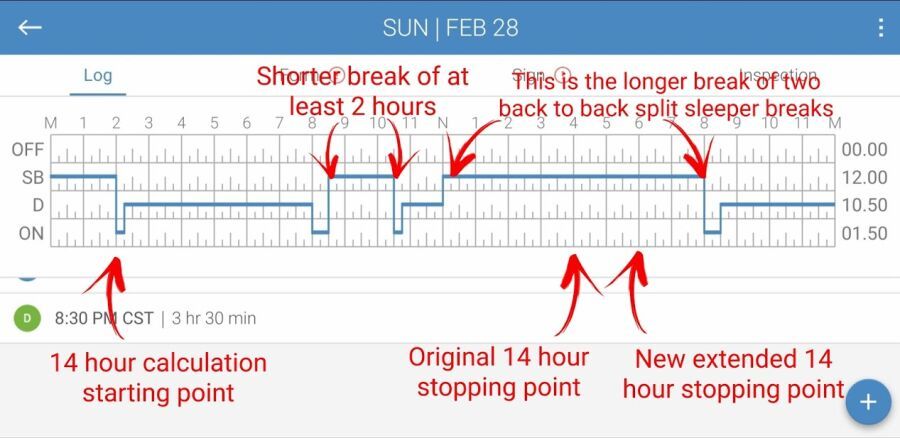Let Me See If I Understand...
Topic 30431 | Page 1
Yes but if splitting 2/3 and 7/8 the 7/8 must be sleeper!
Here are the four main basic points of the split sleeper berth rule as it is presented in the FMCSA “green book.”
- You may divide your 10-hour break into two separate breaks. One break has to be at least 2 hours logged as off duty or sleeper berth. It can also be logged as any combination of the two.
- The other break must be a minimum of 7 hours. The longer of the two breaks must be logged as sleeper berth.
- When you combine the two breaks they must total 10 hours.
- Neither break period counts against your 14-hour clock.
Let’s make one thing clear. Only 10 consecutive hours off-duty will fully reset your 11 and 14-hour clocks. You cannot fully reset your 11-hour and 14-hour clocks when utilizing the split-sleeper-berth provision. It’s important that you realize that. You will restore specific amounts of time to them. At the same time you will be extending the limit on your 14-hour clock.
In order to satisfy that 10-hour total, you could do one break for 2 hours and the other break for 8 hours. Or you could do one break for 3 hours and the other for 7 hours. You can also do any combination in between those two limits as long as the total of your two breaks equals 10 hours. You could do 2 hours and 15 minutes for one and 7 hours and 45 minutes for the other. You’ve got some flexibility here. Any combination within the prescribed limits works.
You just have to meet these requirements:
- Make sure you meet the two minimum requirements.
- Make sure your combined breaks equal 10 hours.
- Make sure the longer break is logged in the sleeper.
Sleeper Berth:
The portion of the tractor behind the seats which acts as the "living space" for the driver. It generally contains a bed (or bunk beds), cabinets, lights, temperature control knobs, and 12 volt plugs for power.
CSA:
Compliance, Safety, Accountability (CSA)
The CSA is a Federal Motor Carrier Safety Administration (FMCSA) initiative to improve large truck and bus safety and ultimately reduce crashes, injuries, and fatalities that are related to commercial motor vehicle
FMCSA:
Federal Motor Carrier Safety Administration
The FMCSA was established within the Department of Transportation on January 1, 2000. Their primary mission is to prevent commercial motor vehicle-related fatalities and injuries.
What Does The FMCSA Do?
- Commercial Drivers' Licenses
- Data and Analysis
- Regulatory Compliance and Enforcement
- Research and Technology
- Safety Assistance
- Support and Information Sharing
Fm:
Dispatcher, Fleet Manager, Driver Manager
The primary person a driver communicates with at his/her company. A dispatcher can play many roles, depending on the company's structure. Dispatchers may assign freight, file requests for home time, relay messages between the driver and management, inform customer service of any delays, change appointment times, and report information to the load planners.HOS:
Hours Of Service
HOS refers to the logbook hours of service regulations.
Let’s make one thing clear. Only 10 consecutive hours off-duty will fully reset your 11 and 14-hour clocks. You cannot fully reset your 11-hour and 14-hour clocks when utilizing the split-sleeper-berth provision. It’s important that you realize that. You will restore specific amounts of time to them. At the same time you will be extending the limit on your 14-hour clock.
Yes, I understand the longer of the two breaks have to be in the sleeper.
But, regarding restoring specific hours of time, I'm not sure how that works exactly. Can you give an example?
Here is an example from the revised High Road Training program. The log example uses back to back split sleeper breaks. For this discussion, I only talk about the one shown on the log example. This example assumes the driver is not running on recaps and started his day with full 11 and 14 hour clocks.

Our driver started his day at 0200 (2:00 a.m.) He performed a 15-minute pre-trip inspection , and then proceeded to drive at 2:15 a.m. He drove 5 hours and 45 minutes, arriving at his consignee at 0800. His appointment was for 0830, so he is 30 minutes early. He backs into the door they’ve assigned him and logs 30 minutes of on-duty time. Then he decides to switch his logs to sleeper berth and take a little rest while he is waiting for them to unload him. He gets a full 2 hours of rest before he has to log back on duty to get his paperwork signed and check out with security.
Now he drives for 1 hour and 15 minutes to his next shipper’s location. Unfortunately they are not ready for him, but they will allow him to park on their property until they can get his load ready. He parks and logs himself onto the sleeper berth line. It’s a good thing he does too. They take a lot of time to get his trailer loaded. Finally he is loaded at 2000 (8:00 p.m.). He logs himself back on duty, checks his load and gets his paperwork before starting his drive. Now he needs to know how many hours he has to drive.
Here is how that works. He got the first half of his split sleeper done when he took the 2-hour break at his consignee. His original 14-hour clock was to expire at 1600 (4:00 p.m.) because he started his day at 0200 (2:00 a.m.). The rules say that neither break counts against the 14-hour clock, so that changes the time his 14-hour limit runs out. He took 2 hours off, so that extended his 14-hour limit to 1800 (6:00 p.m.).
Then he took the second half of the split sleeper while waiting to be loaded at his shipper. That gives him a total of 10 hours off duty when he combines those two breaks. This allows him liberty to drive again, but he needs to know how many hours he can use now. Since the 8-hour break he took doesn’t count against his 14-hour clock, we need to know how many hours were left on his 14-hour clock when he started that 8-hour break. That’s simple - he started it at noon. We know that he had 6 hours left on his 14-hour clock at noon. His first break had extended his 14-hour clock to 1800 (6:00 p.m.). Therefore he will still have 6 hours left after the 8-hour break. That 8-hour break does not count against his 14-hour clock. His new 14-hour clock expires at 0200 (2:00 a.m.). But wait, there’s more!
We need to know how many driving hours he has now. That is what his 11-hour clock represents. If you look at his logs above you will see that he started his day at 0200. He has driven a total of 7 hours before starting his second half of his split-sleeper berth. That is what he has used from his 11-hour clock. Then you can see that he has used up 8 hours of his 14-hour clock. That is the combined total of on duty and driving time. Those hours are used up. What remains will be used in our new calculation. Remember the 2-hour break did not count against the 14-hour clock. That moved his 14-hour clock from expiring at 1600 (4:00 p.m.) to expiring at 1800 (6:00 p.m.). When he began his second break he had 6 hours remaining on his 14-hour clock and 4 hours remaining on his 11-hour clock. After he completes that second break there is a new calculation.
We now must add in the time he gets back for taking a total of 10 hours with his combined two breaks. He gets back the total of the time he used prior to his first break. Can you remember what he did? He started at 0200 (2:00 a.m.). We come up with a total of 45 minutes on duty when we combine his pre-trip inspection and the time he used while checking in and finding his door at his consignee. He also had a total of 5 hours and 45 minutes drive time. By adding his driving time and his on-duty time together, we come up with a total of 6.5 hours to be added to his 14-hour clock. After his second break he will have 6.5 hours to be added on his 14-hour clock and 5 hours and 45 minutes added on to what remains of his 11-hour clock. The 5 hours and 45 minutes of driving time will be added to his remaining 4 hours, giving him a new total of 9.75 hours for his 11-hour clock. The 6.5 hours from the start of his day to the point where he started his first break, is added to the 6 hours he had remaining. Giving him 12.5 hours on his 14-hour clock, which means his new 14-hour limit expires at 8:30 a.m.
Pre-trip Inspection:
A pre-trip inspection is a thorough inspection of the truck completed before driving for the first time each day.
Federal and state laws require that drivers inspect their vehicles. Federal and state inspectors also may inspect your vehicles. If they judge a vehicle to be unsafe, they will put it “out of service” until it is repaired.
Consignee:
The customer the freight is being delivered to. Also referred to as "the receiver". The shipper is the customer that is shipping the goods, the consignee is the customer receiving the goods.
Shipper:
The customer who is shipping the freight. This is where the driver will pick up a load and then deliver it to the receiver or consignee.
Sleeper Berth:
The portion of the tractor behind the seats which acts as the "living space" for the driver. It generally contains a bed (or bunk beds), cabinets, lights, temperature control knobs, and 12 volt plugs for power.
HOS:
Hours Of Service
HOS refers to the logbook hours of service regulations.Happy 4th OS. I responded back to one a while ago, where I erroneously thought that I had reset my 14 and 11 after the long break of 8 in the sleeper. I was indeed wrong though, it was actually 10.5 consecutive hours that reset it. (2.5 of those were before midnight and I just didnt see them until I went back and looked at it) makes more sense now. Thanks.
HOS:
Hours Of Service
HOS refers to the logbook hours of service regulations.I remember that Davy. I also knew you would figure it out. This stuff takes some time to grasp. The split sleeper is a powerful tool, but only helpful when we understand it. We don't need it everyday, but when we do it can really help us be more productive.
New Reply:
New! Check out our help videos for a better understanding of our forum features

















Preview:








 TT On Facebook
TT On Facebook
I've been reading about "splitting" the 10-hour off duty time. Is this correct?
A driver must be off-duty for at least 10 hours during any 24-hour period, 8 hours of which must be spent in a sleeper.
But, you don't have to take the 10 hours in one fell stroke. You can take a 2-hour break, continue driving until your limit is reached, then take 8 hours, Or, you can take a 3-hour break and take 7 hours later.
As long as your off-duty time totals 10 hours you're OK.
Is this right?